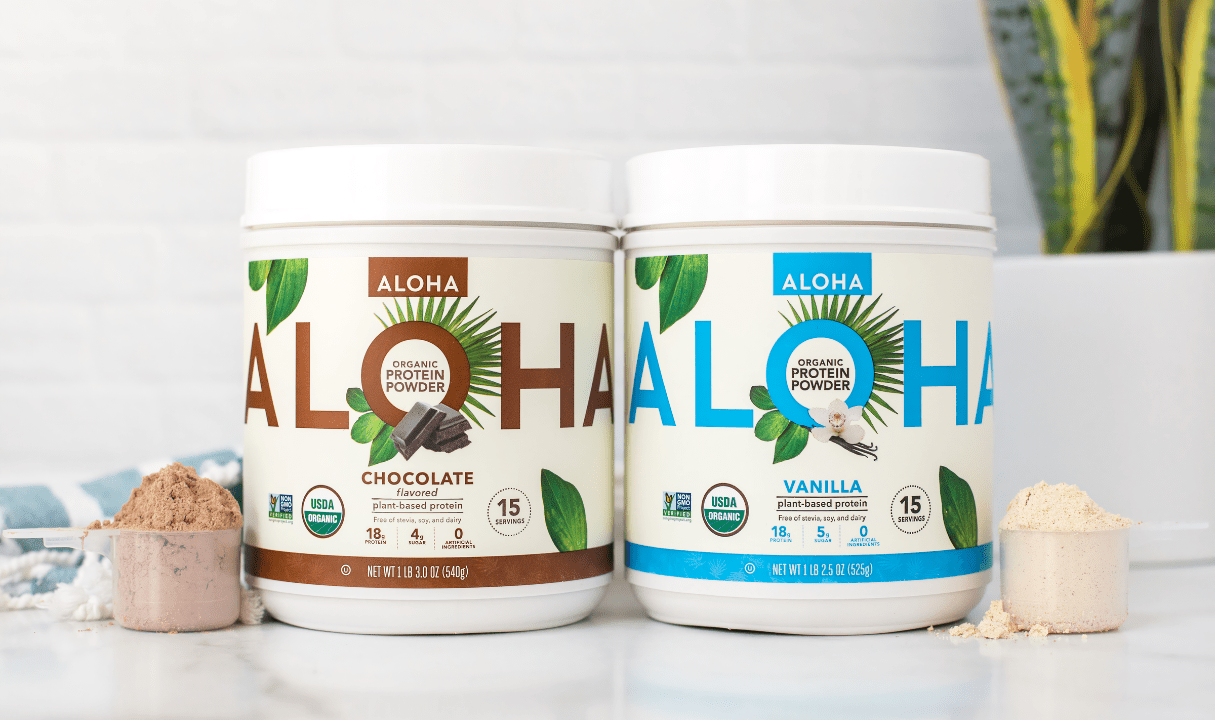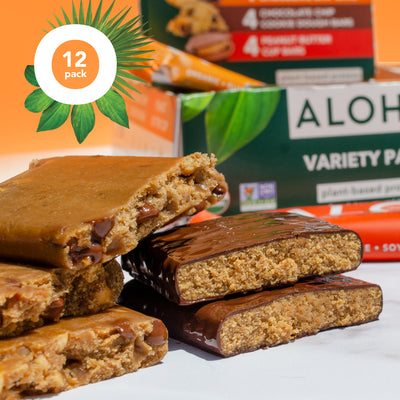Key Takeaways:
- Versatile Uses for Protein Powder: Protein powder can be seamlessly integrated into a wide range of foods and beverages, making it easy to boost your protein intake throughout the day.
- Nutritional Benefits of Plant-Based Protein: Plant-based protein powders support your dietary needs and align with sustainable and ethical eating habits.
- Creative Meal Enhancements: Mixing protein powder into everyday meals and snacks can enhance your diet's flavor and nutritional value without compromising taste.
As a trusted leader in plant-based nutrition, ALOHA offers protein powders crafted from the highest-quality organic, non-GMO ingredients, ensuring that nutrition and taste are at the forefront of your wellness journey.
Protein powder has become an essential component of a balanced diet for health-conscious individuals. It’s not just about supplementing your protein intake; it’s about enhancing your meals and snacks with a versatile, flavorful boost that supports your overall health goals.
In this piece, we’ll explore creative and delicious ways to mix protein powder, helping you maximize your protein supplements' taste and nutritional benefits. Whether new to protein powder or a seasoned user, these ideas will inspire you to get the most out of every scoop.
Creative Ways To Mix Protein Powder For A Tasty Boost
Protein powder isn’t just for shakes—it’s a versatile ingredient that can add a nutritional punch to a variety of foods and drinks, making your healthy choices even more enjoyable. Whether starting your day or fueling up post-workout, here are some creative and delicious ways to mix your protein powder.
Smoothies And Shakes: Classic Mixes With A Twist
While smoothies and shakes are a popular choice, there’s room to get creative. Blend your protein powder with a variety of fruits like mangoes, berries, or bananas to add natural sweetness and vitamins. Toss a handful of spinach or kale for an extra boost, which will mix seamlessly into your drink without overpowering the flavor. Adding a spoonful of nut butter or seeds can also provide healthy fats and satisfy your shake.
Oatmeal And Cereal: Morning Power-Ups
Elevate your breakfast by stirring protein powder into your oatmeal or sprinkling it over cereal. This simple addition turns a standard breakfast into a nutrient-dense meal that keeps you full longer. Mix in some chopped nuts, dried fruits, or a drizzle of honey for added texture and flavor. Whether you prefer your oatmeal warm or overnight style, protein powder blends smoothly, providing a creamy texture that complements the grains.
Baked Goods: Boosting Your Treats
Incorporating protein powder into baked goods is a delicious way to add nutrients to your favorite treats. From muffins and pancakes to homemade energy bars, protein powder can be seamlessly mixed into the batter without affecting the taste. This is especially useful for those wanting to indulge in sweets while maintaining their dietary goals. The added protein enhances the nutritional profile and helps keep you fuller for longer.
Yogurt And Pudding: Creamy And Delicious Options
Mixing protein powder into yogurt or pudding creates a creamy, satisfying snack that is perfect any time of the day. This combination enhances the richness of the yogurt and provides a substantial protein boost, making it ideal for post-workout recovery or a quick, nutritious snack. Add fresh fruits, nuts, or granola for crunch and flavor. The smooth texture of yogurt and pudding pairs well with the powder, making it an easy and enjoyable way to increase your protein intake.
Coffee And Tea: Energizing Blends
Add a scoop of protein powder to transform your morning coffee or tea into a protein-packed beverage. The powder blends smoothly into hot drinks, adding a subtle creaminess and making your morning routine even more nutritious. This simple addition can help keep you full and energized, especially on the go. It’s an excellent way to kick-start your day with caffeine and protein, setting you up for sustained energy levels throughout the day.
Savory Dishes: Unconventional But Tasty
Protein powder isn’t just for sweet dishes—it can also be a surprising yet practical addition to savory meals. Consider stirring a flavorless or mild protein powder into soups, stews, or sauces to increase the protein content without altering the taste. This is a great option for those looking to boost their protein intake in every meal. It’s particularly useful in dishes like vegetable soups or pasta sauces, where the powder can easily blend in, adding a nutritional boost without being noticeable.
Why Choose Plant-Based Protein Powder?
The Nutritional Benefits Of Plant-Based Protein
Like ALOHA offers, plant-based protein powders are crafted from clean, whole-food ingredients such as peas, brown rice, and hemp. These sources provide protein and essential nutrients like fiber, vitamins, and minerals. This makes plant-based protein an excellent choice for those looking to enhance their overall wellness with natural, nutrient-dense options that support a balanced diet.
Improved Digestibility For Better Energy
One of the standout benefits of plant-based protein powders is their ease of digestion. Unlike some animal-based proteins, which can be heavy on the digestive system, plant-based options are gentler, reducing the likelihood of digestive discomfort. This improved digestibility helps you feel lighter and more energized after consuming your protein, making it easier to stay active and focused throughout the day.
A Sustainable Choice For You And The Planet
Choosing a plant-based protein is also a choice for the environment. Producing plant-based proteins requires fewer resources and has a lower carbon footprint than animal-based options. By opting for plant-based products, you support sustainability and contribute to a healthier planet, aligning with ALOHA’s commitment to environmental stewardship.
Versatility In Flavor And Use
Plant-based protein powders offer a versatile addition to your diet, blending seamlessly into various recipes. Whether you enjoy the mild taste of brown rice protein or the nutty richness of hemp, these powders can enhance your smoothies, baked goods, and even savory dishes without overpowering other flavors. This versatility makes it easy to incorporate plant-based protein into your daily routine to suit your taste preferences and lifestyle.
Tips For The Perfect Mix
Choosing The Right Liquid Base
Selecting the appropriate liquid base is crucial for achieving the desired flavor and consistency when mixing protein powder. Almond milk, coconut water, or plain water are popular choices, each offering a different taste and texture. The liquid base not only influences the final flavor but also the smoothness of the mix. Depending on your preference, you can choose a base that complements the protein powder, enhancing its natural taste without overpowering it.
Gradual Mixing For Smooth Consistency
To avoid clumping and ensure a smooth texture, adding the protein powder gradually while stirring or blending continuously is important. This technique helps the powder dissolve evenly into the liquid, preventing lumps and creating a creamy, uniform mixture. Using a blender or a whisk can further enhance the consistency, incorporating the powder more easily. This method is especially useful when mixing protein powder into thicker liquids or foods.
Enhancing Flavor With Natural Additions
Adding natural sweeteners and spices can significantly enhance the flavor of your protein mix. Ingredients like honey, maple syrup, or a dash of cinnamon can complement the taste of the protein powder, making your drink or dish more enjoyable. These additions also allow you to customize the flavor to your liking, creating a more personalized and satisfying experience. You can find the perfect balance that suits your taste preferences by experimenting with different combinations.
Adjusting Temperature For Optimal Mixing
The temperature of the liquid plays a key role in how well the protein powder dissolves. Slightly warm liquids can help the powder mix more easily, reducing clumps and resulting in a smoother texture. This is particularly helpful when using plant-based protein powders, which may require more careful mixing. Adjusting the temperature of your base liquid can be a simple yet effective way to achieve the perfect consistency in your protein shake or recipe.
Experimenting With Thickness And Texture
For those who prefer a thicker consistency, adding ingredients like frozen fruits or a small amount of nut butter can achieve this while boosting nutritional value. These additions make the mixture more filling and add richness to the flavor. Whether making a smoothie or a protein-packed dessert, experimenting with different textures can help you create a satisfying mix that fits your preferences.
How To Choose The Right Protein Powder For Your Needs
Consider Your Flavor Preferences
Flavor is an important factor when choosing a protein powder since it influences how often and how easily you’ll incorporate it into your diet. Opt for flavors like vanilla or unflavored options if you prefer something mild that blends well with various ingredients. Chocolate or other robust flavors might appeal to those who enjoy a richer taste. Consider how you plan to use the protein powder—in smoothies, baking, or other recipes—and choose a flavor that complements your typical food choices.
Assess The Source Of Protein
Understanding the source of protein in your powder is essential, especially if you have dietary restrictions or preferences. Plant-based protein powders, like those made from peas, hemp, or brown rice, offer a clean and sustainable option that is often easier to digest. Each plant-based source provides unique benefits—hemp, for example, is rich in omega-3 fatty acids, while pea protein is known for its high lysine content, which supports muscle repair. Choose a protein source that aligns with your nutritional needs and digestive comfort.
Check The Nutritional Profile
Reviewing the nutritional profile of the protein powder is crucial to ensure it fits your dietary goals. Consider the protein content per serving, but also consider the carbohydrates, fats, and added sugars levels. A well-balanced protein powder should complement your diet without adding unnecessary calories or sugars. Additionally, check for essential amino acids for muscle recovery and overall health.
Ethical And Environmental Considerations
If sustainability and ethical sourcing are important to you, look for protein powders that are certified organic, non-GMO, and produced using environmentally friendly practices. Brands like ALOHA are committed to using responsibly sourced ingredients, ensuring their products are good for you and the planet. Choosing a protein powder that aligns with your ethical values can make your purchase more meaningful and satisfying.
Incorporating Protein Powder Into A Balanced Diet
Enhancing Everyday Meals
Protein powder can easily be added to a variety of everyday meals to increase their nutritional value. For breakfast, stir a scoop into your yogurt or cereal for a protein boost that will keep you full throughout the morning. Consider mixing protein powder into your soups, stews, or salad dressings when preparing lunch or dinner. This enhances the protein content, provides a creamy texture, and adds flavor to your dishes.
Snacking Smarter With Protein Powder
For those mid-day cravings, incorporating protein powder into your snacks can help you stay energized and satisfied. Blend it into homemade energy balls, protein bars, or healthy desserts like protein-packed brownies or cookies. These delicious snacks provide a sustained energy release, making them perfect for fueling your day. With various flavors available, it’s easy to create snacks you’ll look forward to eating.
Balancing Nutritional Intake
While protein powder is a great way to add more protein to your diet, maintaining balance is important. Pair it with other macronutrients like healthy fats and carbohydrates to create well-rounded meals. For example, combining protein powder with fruits and vegetables in a smoothie ensures you get fiber, vitamins, and minerals. This holistic approach to nutrition supports overall well-being and helps you make the most out of your protein powder.
Final Thoughts
Embracing protein powder's versatility allows you to enrich your diet in ways that go beyond the traditional shake. Whether adding it to your morning oatmeal, blending it into smoothies, or experimenting with savory dishes, protein powder can seamlessly fit into various meals and snacks, offering both nutritional benefits and enhanced flavors. This adaptability makes it a valuable addition to any health-conscious lifestyle, enabling you to meet your protein needs while enjoying various culinary possibilities.
As you explore different ways to incorporate protein powder into your diet, remember that it’s not just about convenience—it's about making thoughtful choices that align with your health goals. By creatively integrating protein powder, you’re boosting your protein intake and fostering a more balanced and enjoyable approach to nutrition. The key is to find what works best for you, ensuring that each meal contributes to your overall well-being while satisfying your taste buds.
Read also:
- How To Make Protein Ice Cream: A Complete Guide
- How Many Protein Bars Can You Eat In A Day?
- Protein Shake vs. Protein Bar: Which One Should You Take?
Frequently Asked Questions About What To Mix Protein Powder With
What are some unique ways to mix protein powder beyond smoothies?
You can mix protein powder into oatmeal, baked goods, yogurt, or savory dishes like soups and sauces to boost their nutritional content without affecting taste.
Can I add protein powder to hot beverages like coffee or tea?
Protein powder can be added to hot drinks like coffee or tea. It blends smoothly, adding a subtle creaminess and nutritional boost.
Is it possible to use protein powder in baking?
Absolutely! Protein powder can be incorporated into baked goods such as muffins, pancakes, and energy bars, enhancing their nutritional value without compromising taste.
Can protein powder be mixed with non-dairy alternatives like almond or coconut milk?
Yes, non-dairy alternatives like almond or coconut milk are excellent bases for mixing protein powder, offering different flavors and textures.
How can I avoid clumps when mixing protein powder into liquids?
To avoid clumps, gradually add the protein powder while stirring or blending continuously. Using a whisk or blender can also help achieve a smooth consistency.
Is protein powder only for sweet dishes, or can it be used in savory recipes?
Protein powder can be used in savory dishes, particularly when using flavorless or mild protein powders, making it a versatile addition to soups, stews, and sauces.
What are the benefits of using plant-based protein powder over whey?
Plant-based protein powders are often easier to digest, provide additional nutrients like fiber, and align with sustainable and ethical dietary choices.
Can protein powder be mixed with yogurt or pudding for a snack?
Yes, mixing protein powder with yogurt or pudding creates a creamy, protein-rich snack that is satisfying and nutritious.
Is it safe to mix protein powder with hot liquids?
Mixing protein powder with hot liquids is generally safe, though it's recommended to let the liquid cool slightly before mixing to avoid altering the texture or taste.
How do I choose the right protein powder for my dietary needs?
When choosing a protein powder, consider your flavor preferences, protein source (e.g., plant-based vs. whey), nutritional profile, and ethical or environmental considerations.
Sources:
- Hertzler, S. R., Lieblein-Boff, J. C., Weiler, M., & Allgeier, C. (2020). Plant Proteins: Assessing Their Nutritional Quality and Effects on Health and Physical Function. Nutrients, 12(12), 3704. https://doi.org/10.3390/nu12123704
- Berrazaga, I., Micard, V., Gueugneau, M., & Walrand, S. (2019). The Role of the Anabolic Properties of Plant- versus Animal-Based Protein Sources in Supporting Muscle Mass Maintenance: A Critical Review. Nutrients, 11(8), 1825.
- Is plant-based protein for you? Here’s what you need to know. (n.d.). Www.uclahealth.org. https://www.uclahealth.org/news/article/is-plant-based-protein-for-you-heres-what-you-need-to-know#:~:text=A%20big%20benefit%20to%20plant
ALOHA's products are not intended to treat, diagnose, mitigate, prevent, or cure disease. ALOHA's products should not replace prescribed medications or the variety of foods important to a healthful diet.
Do not self-diagnose any health condition. Work with your healthcare provider to determine how best to achieve optimal health.











